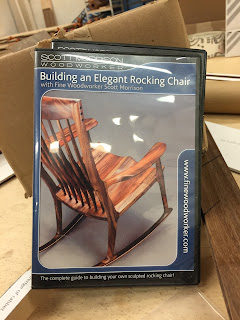We had a nice intimate gathering this month, when one of our more ambitious members – Lupe Nielsen – presented an amazing pair of Sam Maloof inspired rocking chairs and matching side tables. Built in just 320 hours! More about her process, and tips and tricks later...
But first, we had our usual show and tell.
But first, we had our usual show and tell.
Pam brought a bark carving that she's been working on - her goal this summer is to put in 10 minutes a day with a carving knife. We were all envious of that dedication!
Mike brought a few examples of some lasered plywood pieces he's been working on. He’s been trying to perfect his technique, and asked for advice about keeping plywood flat in his laser engraver. (We all said– buy better plywood!)
These panels could potentially end up in a West Elm catalog, which would be very cool for him!
And Kate brought a few samples of her engraved journal covers,
she's been taking a CAD class and working with laser engraving.
That's some amazing work!
We were also sorry to hear that we were losing a few members - five in total are moving away. We’ll miss Ted’s expertise, Bill’s humor, Pete’s extraordinary cutting boards, Russ’s thoughtful questions, as well as words of wisdom from our former blog writer John, who is moving permanently to Arizona. It’s always a shame to have members move away, but we wish them well with their relocations. May your shops be cool and productive.
And finally - on to the main event. As always, Lupe’s presentation was detailed and filled with background information.
Lupe explained that although she's been doing woodworking for about five years, up until three years ago, she would not have had the necessary skills to build these pieces. These demanding chairs required a full range of woodworking expertise, including lathe work, coopering (as in barrel-making), carving, grinding, bandsaw work, bent lamination, sculpting, and more. Not for a rookie!
She did quite a bit of research first, reading several books including Maloof’s biography.
She thoroughly explored his thoughts about the evolution of this chair, and then researched the various plans that were available, including Charles Brock’s version, William Ng’s design, and eventually settled on Scott Morrison plan.
One reason was that his plan required only 8/4 lumber, which is much easier to acquire than the 12/4 lumber that is often required in other's plans. Oh, and did I mention that she decided to build a couple of matching tables too? I'm not sure where she gets her energy, but she has all of my respect.
She warned us that all plans include mistakes, and suggested that a thorough understanding of this chair is necessary before starting it.
Scott's chair design required these special router bits
to cut this mated joint.
And in addition to those, she bought or borrowed a Lie-Nielsen spoke shave and Auriou number nine rasp.

After all that shaping - (whew!) – she THEN used a die grinder and a Holy Galahad wheel on her Milwaukee grinder.
A particular challenge was the bent lamination of the rockers - she built a one-part jig and laminated a rocker, but was unhappy with it. It needed even pressure for a better glue-up, so she ended up making a two part jig that allowed her to apply better pressure for a stronger lamination.
These Klingspor memory blocks helped her with the final sanding on all the sculpted parts.
If you know anything about Lupe, you know she is a stickler for a good finish on her pieces. For first coat was Tried and True Danish oil.
This was then followed by Maloof's own poly/oil finish. She started with 180 grit wet sanding, and by the time the last coat was applied, she was up to 1500 grit paper. Whew! I think she applied six or seven coats, before the final wax.
Why do we always pointed out the flaws in our pieces?
Lupe explained that she had a few areas that required some TLC. She ended up using a slow curing tinted epoxy to fix a few defects, and some Mohawk stain markers for touching up the epoxied areas.
Honestly – you had to put on your readers to see any of her mistakes!
Lupe explained that she had a few areas that required some TLC. She ended up using a slow curing tinted epoxy to fix a few defects, and some Mohawk stain markers for touching up the epoxied areas.
Honestly – you had to put on your readers to see any of her mistakes!
The evening wrapped up with everyone trying out her chairs. We could be more amazed at the work she does, nor more pleased with her efforts. Great work, Lupe!


































